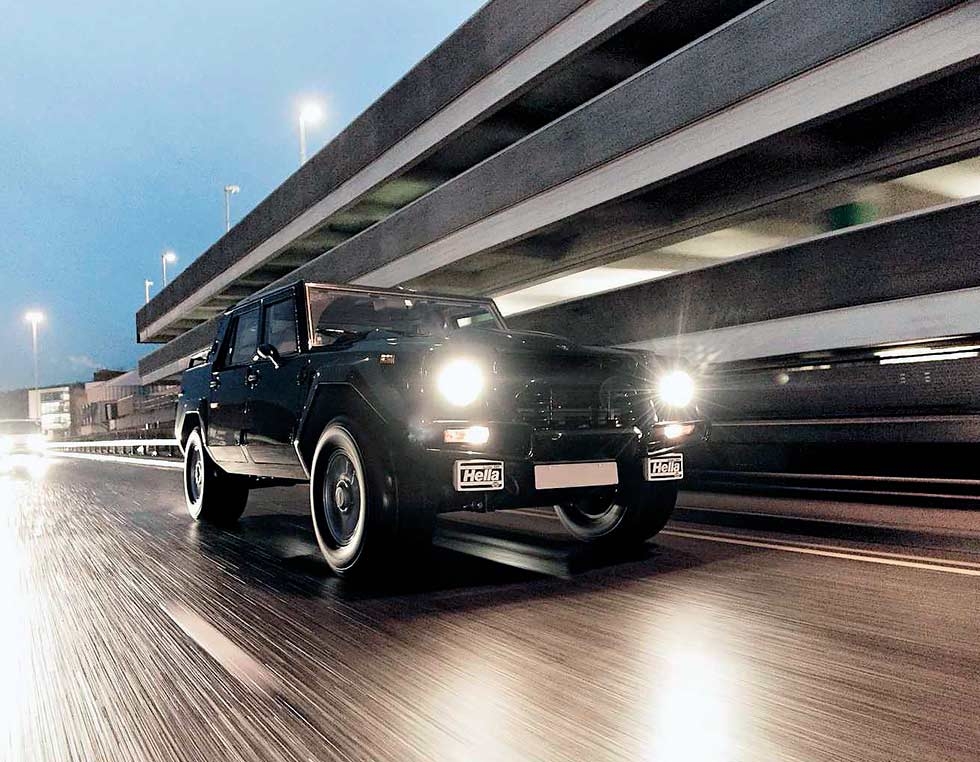
Rambo Lambo. Love it or loathe it; either way, you have to respect it. Lamborghini’s monstrous V12-powered LM002 off-roader was built to cross deserts at high speed. So why did we take it to High Wycombe town centre? Words Mark Dixon. Photography Tim Andrew.
The Countach of off-roaders, rebuilt from the ground-up. Rare restoration of a ‘Rambo Lambo’.
Let’s come clean: that headline is not ours. It was coined by Car and Driver magazine in 1987 for a road test by the legendary Brock Yates. Frankly, though, it’s too good not to steal. ‘Rambo Lambo’ sums up the LM002 perfectly. Completely over the top, ridiculously pumpedup, an epitome of 1980s excess – yes, that’s this Lamborghini in a nutshell. You will not be surprised in the slightest to hear that Sylvester Stallone owned one. As did Colonel Muammar Gaddafi.
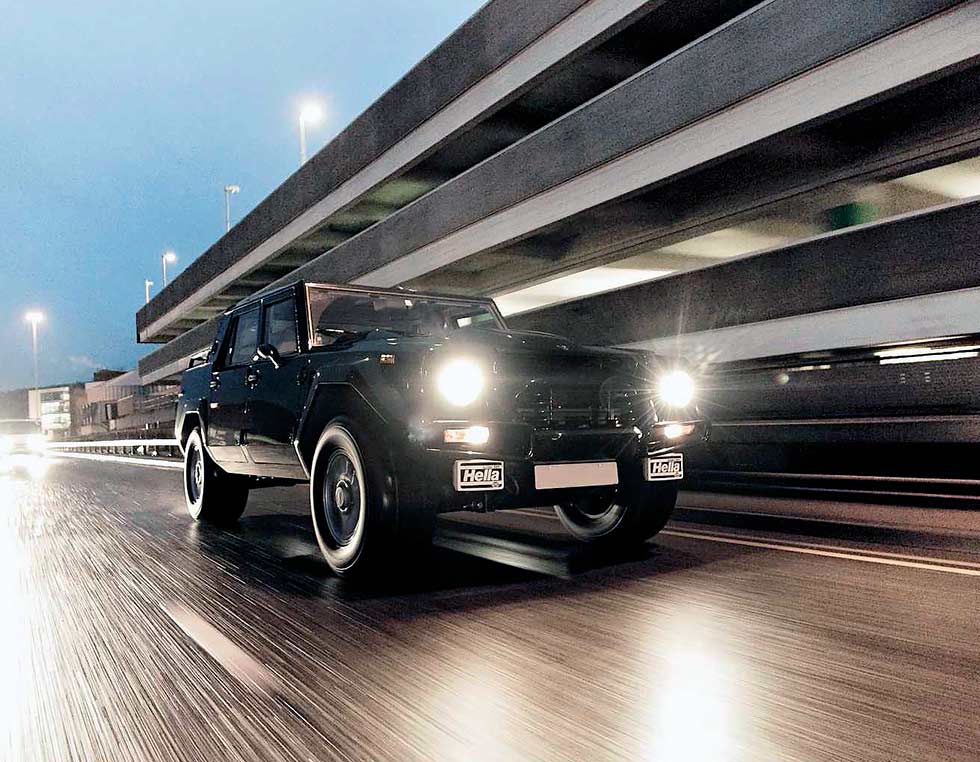
The US freeways, the Libyan deserts: these are the LM002’s natural environments. Indeed, our feature car was delivered new to Los Angeles. So why are we driving one around the centre of High Wycombe, a place not widely known for having either broad palm tree-lined boulevards or expanses of sandy wastes?
Because, quite simply, that’s where the UK’s – and indeed, the world’s – leading specialist in these super-4x4s is based. The Modena Group has now restored half-a-dozen LM002s and remakes a number of the fiddly little parts that Lamborghini itself can’t supply. And the car in our pictures, which is owned by a British oil executive (a handy job to have, if you drive one of these), has had a ground-up restoration of a kind rarely afforded to these until-recently unloved Lamborghinis.
The LM002 has always been the black sheep of the Lamborghini family. It has its origins in a 1977 prototype called the Cheetah that was being pitched as an all-purpose vehicle for the American military by Mobility Technology International (MTI), who teamed up with Lamborghini to take advantage of its engineering expertise. The Cheetah – which is shown undergoing testing on page 126 – was a rear-engined, tubular-chassised and glassfibre-bodied 4×4 that was powered by a 5.9-litre Chrysler V8. Although not fully developed, it made its debut at the 1977 Geneva motor show.
So far, so promising. Trouble was, MTI had no money and neither did Lamborghini, and the Cheetah needed a lot more work. Enter a fairy godmother in the unlikely shape of BMW. The German giant was planning what would become the M1 junior supercar, and commissioned Lamborghini to build four prototypes, followed by up to 400 production cars on the then-mothballed Espada assembly line.
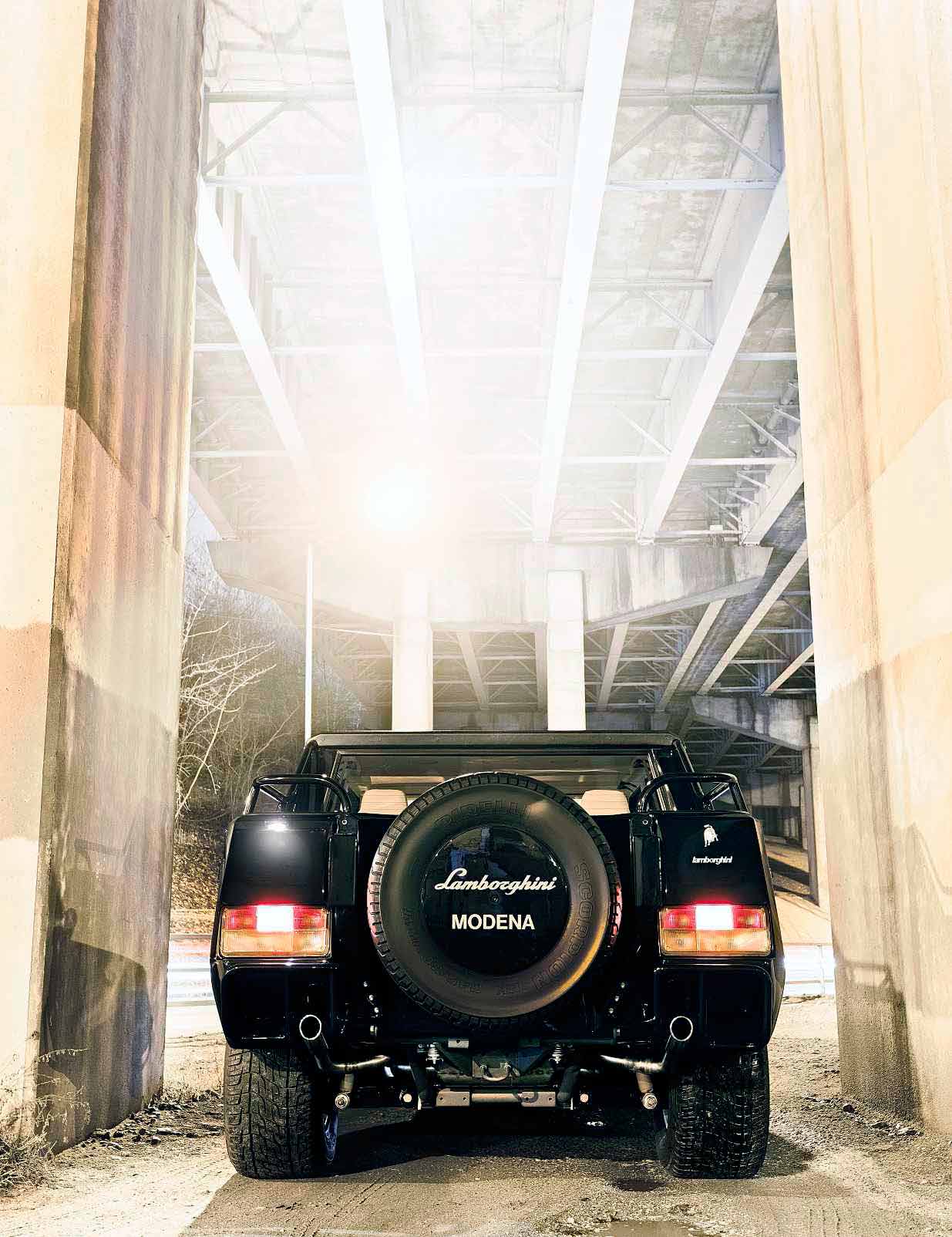
Lamborghini needed contracts like this because, due to the recent introduction of Type Approval legislation, it had suddenly found itself without any products it could continue to sell, other than the Countach. Now, thanks to some up-front cash from BMW to pay for parts and tooling, and a loan from the Italian government to underwrite the costs of the M1 and Cheetah projects, its cashflow situation was eased. But the relief was temporary. MTI was threatened with legal action by Ford for alleged plagiarism of its XR311 off-road prototype, and pulled out of the Cheetah programme.
It never rains but it pours; Lamborghini got behind schedule with the M1, and now it was BMW’s turn to pull out. They annulled the project and moved production to Baur in Germany, although whether they ever got their money back is something known only to their accountants… Lamborghini was left with just the Countach 400S to sell, plus the unfinished Cheetah project. Not an encouraging prospect.
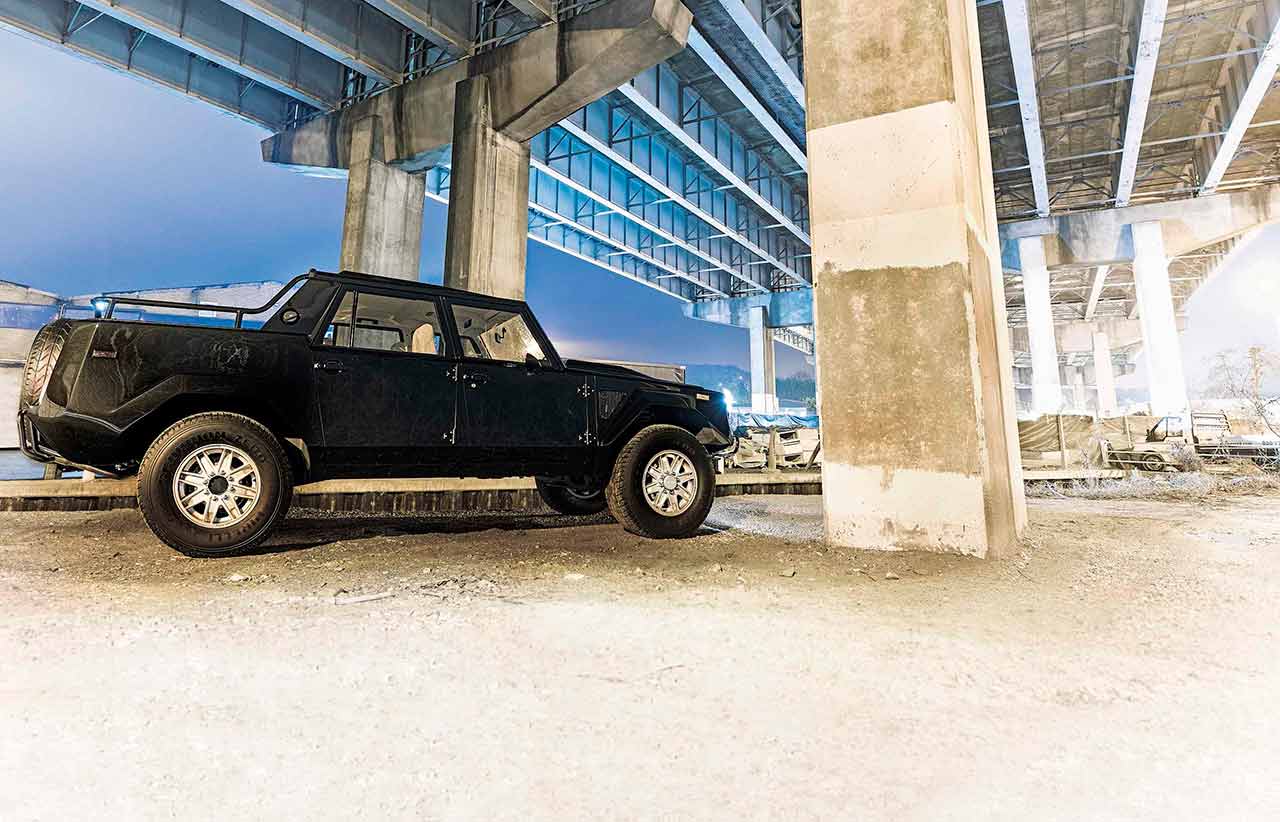
Then Lamborghini’s rollercoaster bottomed out and started climbing again. Oddly enough, having an official receiver appointed in late 1978 was a real stroke of luck, because Dr Alexandro Artese happened to be a car enthusiast. He had the good sense to recruit respected former Maserati engineer Giulio Alfieri for Lamborghini, and that helped boost morale at the factory and confidence with would-be investors. It’s said that Alfieri even paid wages for the workers out of his own bank account when times were particularly tough.
The rollercoaster continued to ascend as two wealthy Swiss brothers, Patrick and Jean-Claude Mimran, successfully bid $3m for the company and re-registered it. Things were looking up – and a small group of engineers at the factory started tinkering with the Cheetah project again. The Cheetah itself didn’t exist, having been written off in an accident during testing, so Lamborghini built a new vehicle. Codenamed LM001 – the initials standing for Lamborghini Militari – it was exhibited at Geneva in 1981. It was still rear-engined, like the Cheetah, and intended to have either a 4.75-litre Countach V12 or a 360ci (5.9-litre) AMC V8. However, testing showed that the rearwards weight distribution made the front end disconcertingly light under hard acceleration, so the engineers went back to their drawing boards.
Enter LM002 – or, as it was initially known, LMA, the ‘A’ for Anteriore, because the engine was now in the front. Not only did this cure the handling problem, but it meant there was room on the deck behind the cabin for extra bodyguards, soldiers, dancing girls or whoever. The prototype LM002 was shown in 1982 and entered production in 1986. Lamborghini would build 301 of them over the next five years but, although it was the car of choice for some of the world’s less desirable dictators – US armed forces happily blew up Saddam Hussein’s son Uday’s LM002 in 2004 – it was never actually sold to any foreign armies, Middle Eastern or otherwise, despite what you may read on the internet.

The LM002 was very much a luxury off-roader rather than the ‘Humvee’ it was once intended to be, back in the days of the ill-fated Cheetah. Something that is quite evident from the interior pictured on the preceding photo-spread. This late example of an LM002 – it has the desirable alloy wheels fitted towards the end of production, rather than the steel rims used previously – left the factory painted dark metallic blue with a tan interior, but is now Lamborghini nero metallic with crema soft trim. Very supercar.
‘The owner’s had this car for 20 years and absolutely loves it,’ explains Graham Schulz, proprietor of The Modena Group. ‘We’ve looked after it since he first bought it, and about a year ago he asked us to restore it to better-than-new condition. As far as we know, no-one’s ever gone into an LM002 in this depth. The factory was very supportive of what we were doing; we sent them photos regularly, and whenever I talked to Bruno in the parts department he’d ask how we were getting on. We reckon it’s now the best example in the world.’
Like other vehicles of its ilk – anyone who has been inside a Hummer will know what we mean – the LM002 achieves a ‘reverse Tardis’ effect: it looks huge on the outside but not at all big on the inside. That’s because much of the space is taken up by an enormous transmission tunnel. This LM002 is a lot more accommodating for the driver than most, however, because Modena has adjusted the reach of the steering column and moved the seat rearwards to suit its six-foot-plus owner. It’s definitely a four-seater, and surplus minions must perch less-than-comfortably outside on the benches above the rear wheels – although even that option is denied to passengers in this vehicle, which has a massive detachable locker bolted to the loadspace floor.
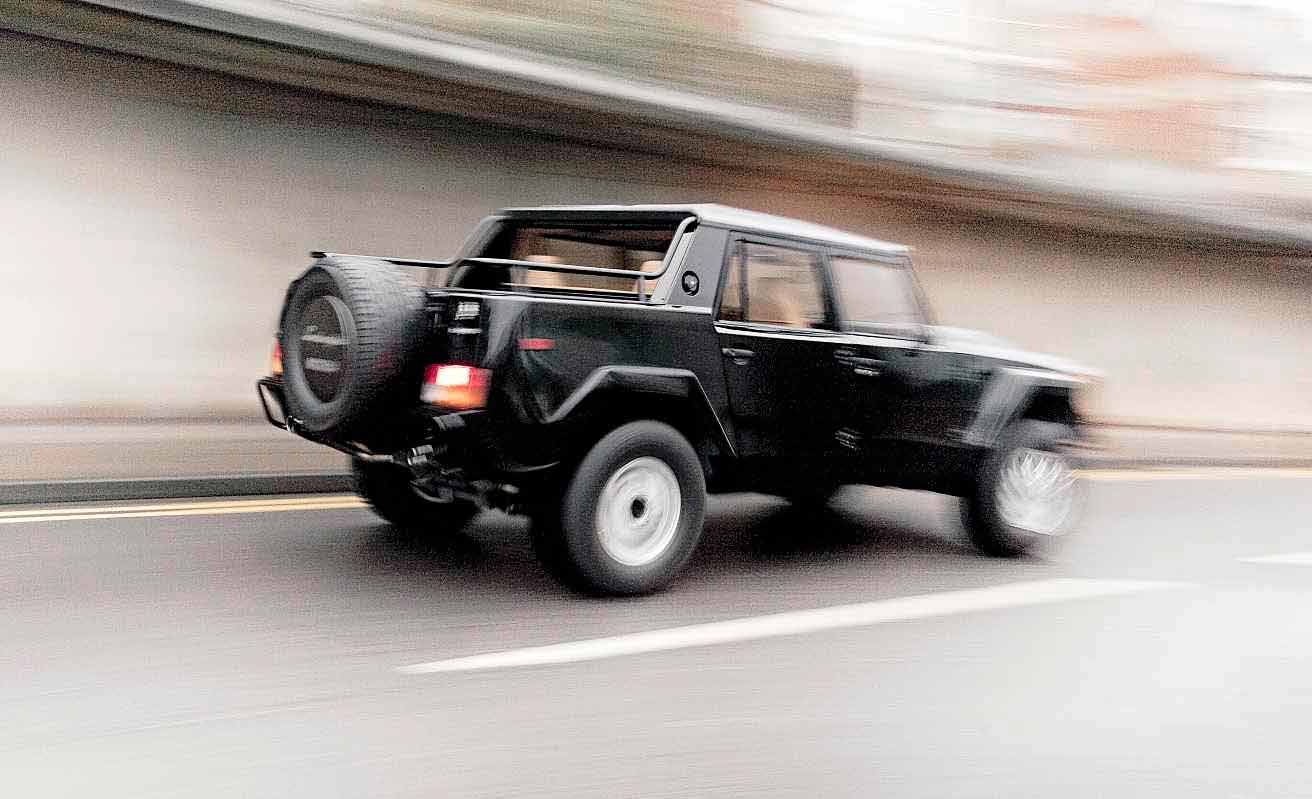
Even taking into account the Alice in Wonderland growth in car proportions that’s occurred over the last 30 years, the LM002 is still a monstrous vehicle. ‘The closest thing to a street-legal Tiger tank known to man,’ was Brock Yates’ introduction in his 1987 road test, and you do need a certain amount of chutzpah to be seen filling it up on the average British forecourt, although you can take some small relief in knowing that the 9.5:1 compression-ratio V12 will run happily on Regular rather than Super Unleaded. ‘So, Graham, what is the average fuel consumption?’ ‘About 5-8mpg,’ deadpans the Modena boss.
Lamborghini did experiment with a diesel-powered LM002, using a 3.0-litre turbocharged straight-six made by VM of Italy, but 150bhp to propel nearly three tonnes was never going to make much sense. Exit LM003. But LM004, which followed a diametrically opposed philosophy, did make it into production. This variant was equipped with a 7.3-litre Lamborghini V12 that had been designed by Paolo Stanzani for powerboat racing, and which gave a claimed 420bhp at 5400rpm.
Autocar was given a demonstration in 1986, part of which involved climbing a 70º hill: ‘Bystanders reported the front wheels coming off the ground. We should be in the Guinness Book of World Records.’
There’ll be no antics like that in High Wycombe this evening, thank you very much. Hoist yourself up into the monochrome cockpit and you’ll find a steering wheel set at an appropriately bus-like angle. Land Rover drivers will be familiar with the lever used to shift between high and low ranges, and perhaps also with the way that you have to climb back out of the vehicle to lock the freewheeling front hubs for off-road use – the freewheels being a token gesture to greater on-road fuel economy. There are limited-slip diffs in both axles and you can manually lock the rearmost one (from inside the cabin, thankfully).
Graham warns that the clutch is exceptionally heavy, something that road testers also commented on back in the day, but in fact it turns out to be not that bad – man up, chaps! Similarly, the gearchange is a bit clunky and can’t be rushed, and the overwhelming impression is of being behind the wheel of an overgrown Range Rover Classic: initially it feels a bit ponderous, but as confidence grows you realise you can really punt this thing around quite effectively. It’s actually very easy to drive, thanks to the high seating position and power-assisted steering.
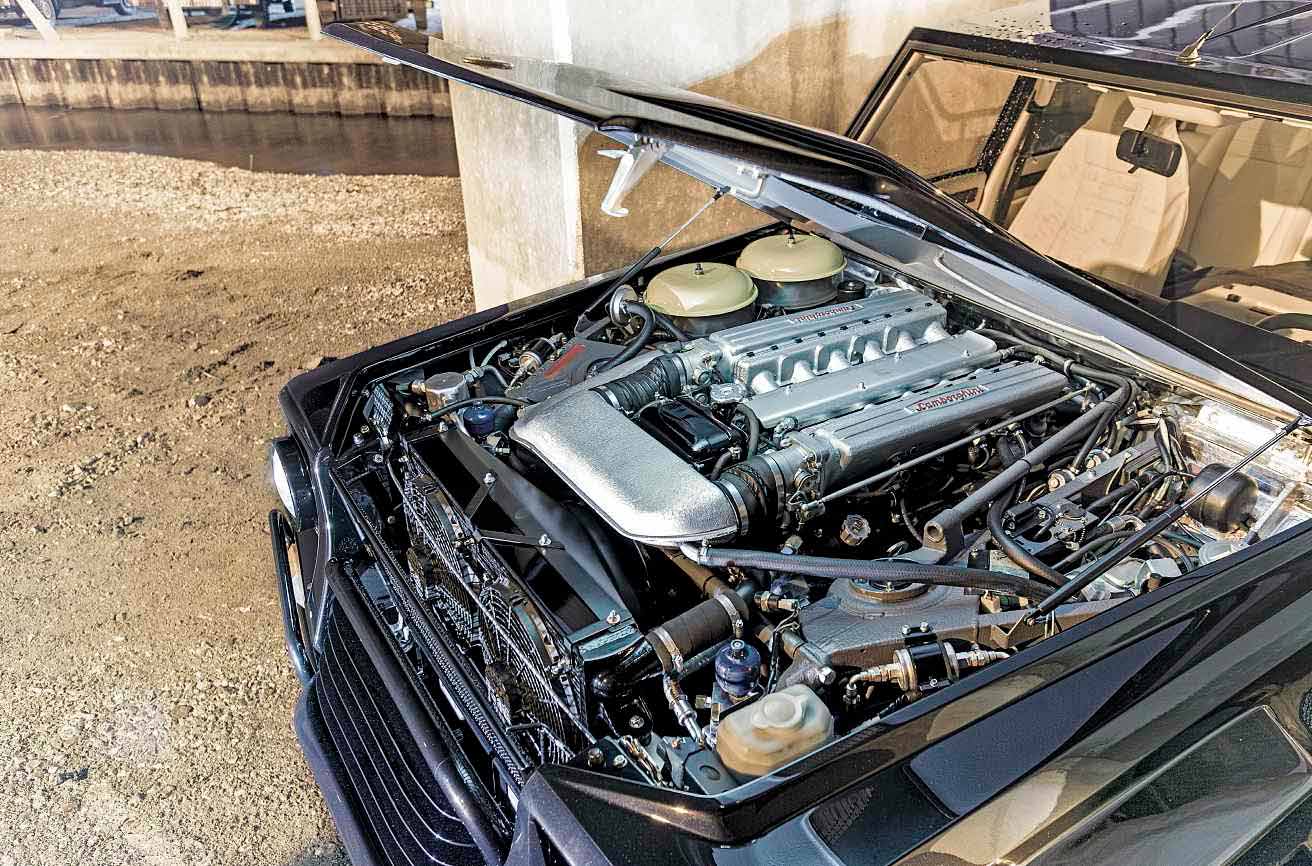
As you would expect from a carb-fed Countach V12, there’s no lack of power but, given that it’s propelling what is basically a four-wheel-drive truck, acceleration is strong rather than supercar-quick – and, of course, the heavy gearchange slows you down a little. But speed is only one weapon in Rambo Lambo’s armoury: it feels (and appears) unstoppable, even without the standard-spec winch that would normally be mounted up front. ‘We decided to leave that off,’ explains Graham. ‘It’s heavy and because of the way it projects, I’m not convinced about its legality…’
The view from the driver’s seat, gazing out over the twin power bulges necessary to clear the V12, is empowering, to say the least, and the roar from the twin exhausts (custom made by Modena) is glorious; the LM002 is not nearly as aristocratically refined as the Countach whose engine it shares but instead emits a macho, lower-pitched mechanical growl that leaves bystanders in no doubt they’re in the presence of something with lots of cylinders and lots of litres. And, indeed, lots of carburettors – there are six big Webers pouring fuel into the V12.
Perhaps this Goliath’s greatest weakness is its lousy turning circle, not helped by the 325-section Pirelli Scorpions that were, until recently, almost as hard to track down as some of the LM002’s more infamous owners. ‘It’s only in the last couple of years that people have started using their LM002s enough to make it worthwhile for Pirelli to produce new tyres,’ explains Graham. ‘The result is that in the past each new tyre cost £2200, whereas tyres from the next batch will be more like £600.’
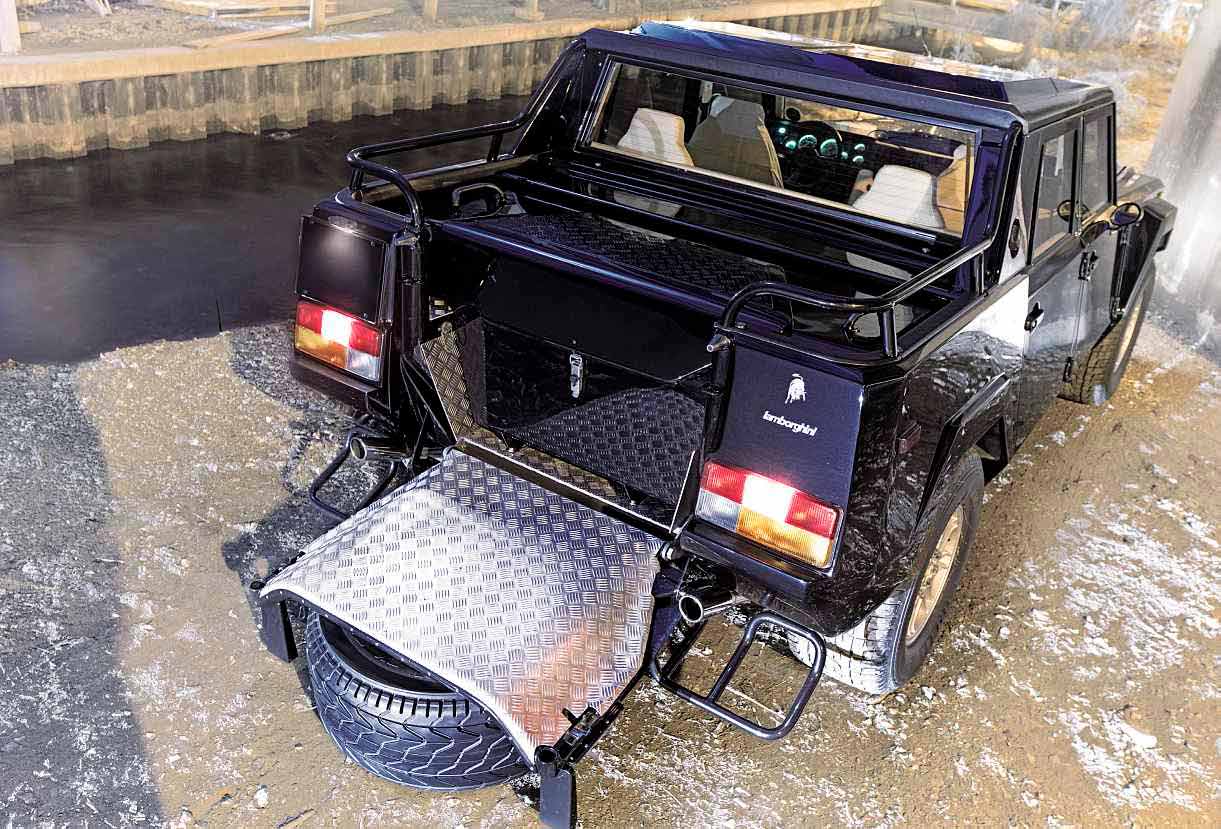
That dramatic price reduction is a good indication of the way LM002s are now starting to take off in a big way, after years of obscurity, says Graham. ‘Not long ago you could buy a good one for 25, 30 or 40 thousand,’ he says, ‘whereas now they’re £100,000 and more. All the classic Lamborghinis are going the same way – and the V12 has a unique appeal. It can’t be long now before the last V12 is built.’
Even by the standards of its day, the LM002 was a dinosaur, a creature completely out of step with the closing years of the 20th century, and its time for roaming free in the new millennium may be fast running out – hunted to extinction by men armed not with spears but with carbon dioxide meters. We’re indeed witnessing a privileged era, a time when dinosaurs ruled High Wycombe.
THANKS TO Graham Schultz at The Modena Group (www.modenagroup.net).
TECHNICAL DATA FILE SPECIFICATIONS 1990 Lamborghini LM002
ENGINE 5167cc light-alloy V12, DOHC per bank, six Weber 44DCNF carburettors
MAX POWER 450bhp @ 6800rpm / DIN
MAX TORQUE 340lb ft @ 5200rpm / DIN
TRANSMISSION Five-speed manual, high/low transfer box, limited-slip diffs in gearbox and axles, four-wheel drive
STEERING Rack and pinion, power-assisted
SUSPENSION Front and rear: double wishbones, coil springs, telescopic dampers
BRAKES Vented discs front, drums rear
WEIGHT c2700kg
PERFORMANCE 0-60mph 7.7sec. Top speed 118mph (Car and Driver test figures, 1987)
‘As far as we know, no-one’s ever gone into an LM002 in this depth. The factory was very supportive of what we were doing’
‘“The closest thing to a street-legal Tiger tank known to man” was Brock yates’ introduction to his 1987 road test’
Right to left from main image, facing page The LM002 has a complicated steel tube-frame substructure, onto which glassfibre outer panels and steel doors are bolted – fortunately this one had not rusted significantly, having spent its early life in Los Angeles; heat exchangers for the heavy-duty air-con system, mounted on each front wheelarch liner, are clearly visible in this shot taken early in the restoration; the interior was completely gutted and retrimmed, with unique dust-proofed switches carefully rebuilt. Originally this vehicle was painted metallic dark blue with tan leather, but the owner requested a colour change to metallic black with cream leather. Left to right, from facing page The V12 engine is basically a 5.2-litre Countach unit, fed by six Weber carburettors; glassfibre panels demanded lots of careful pre-paint prepping for a smooth finish; four-wheel-drive transmission is (whisper it) derived from Fiat commercial vehicle parts; twin rear dampers have to be specially made – and note that the rear brakes on this 2.7-tonne vehicle are drums; massive fuel tank holds 62 gallons, but there was a bigger one for the 7.3-litre V12 option available in the States… Above No surprise that they wrote it off during testing… This is the Cheetah prototype, photographed in Italy (top – note the Fiat 500 in the background) and at an unspecified proving ground in the mid-1970s. It was a much more spartan vehicle than the LM002, and very close in spirit to the Humvees that AM General would produce from 1984.





